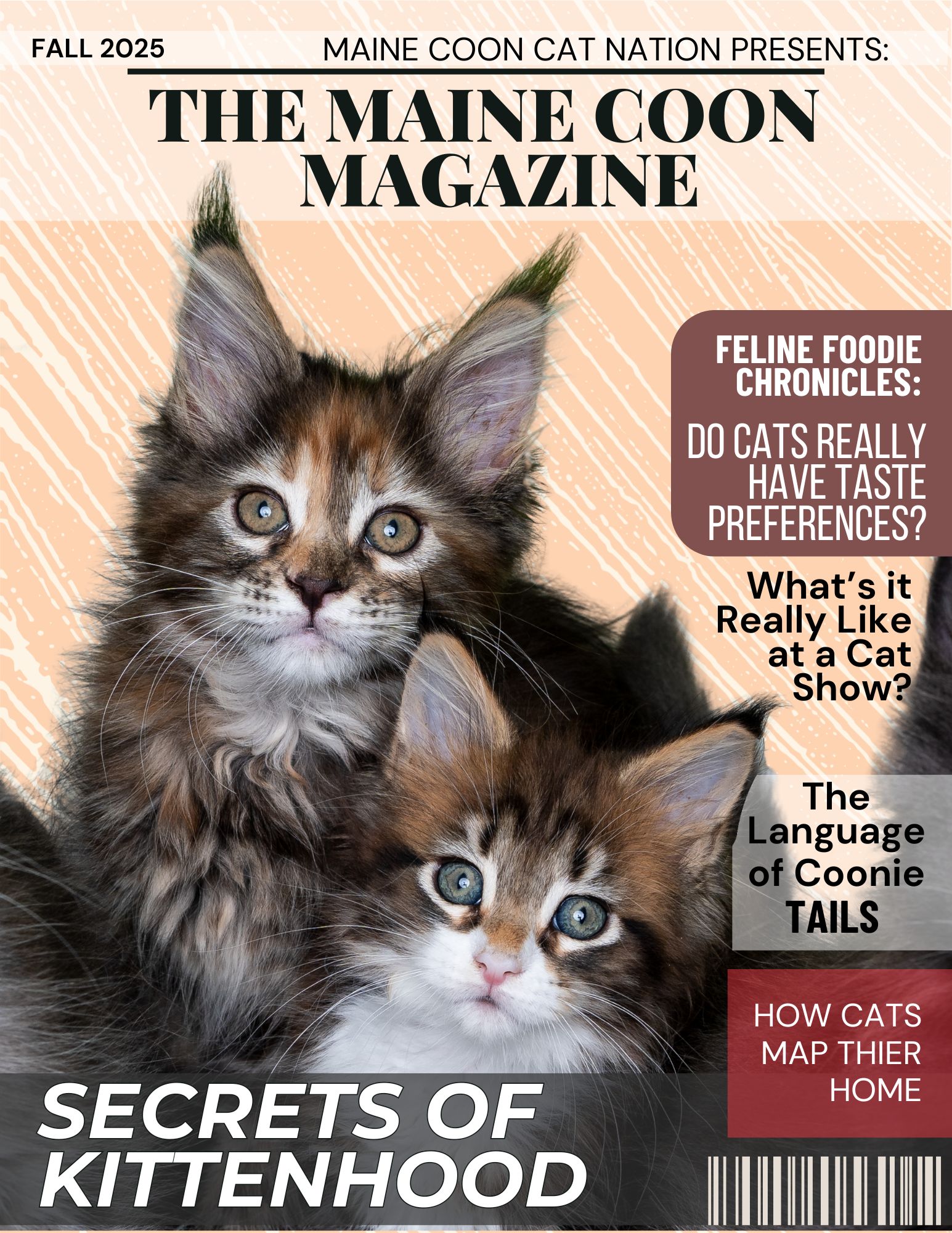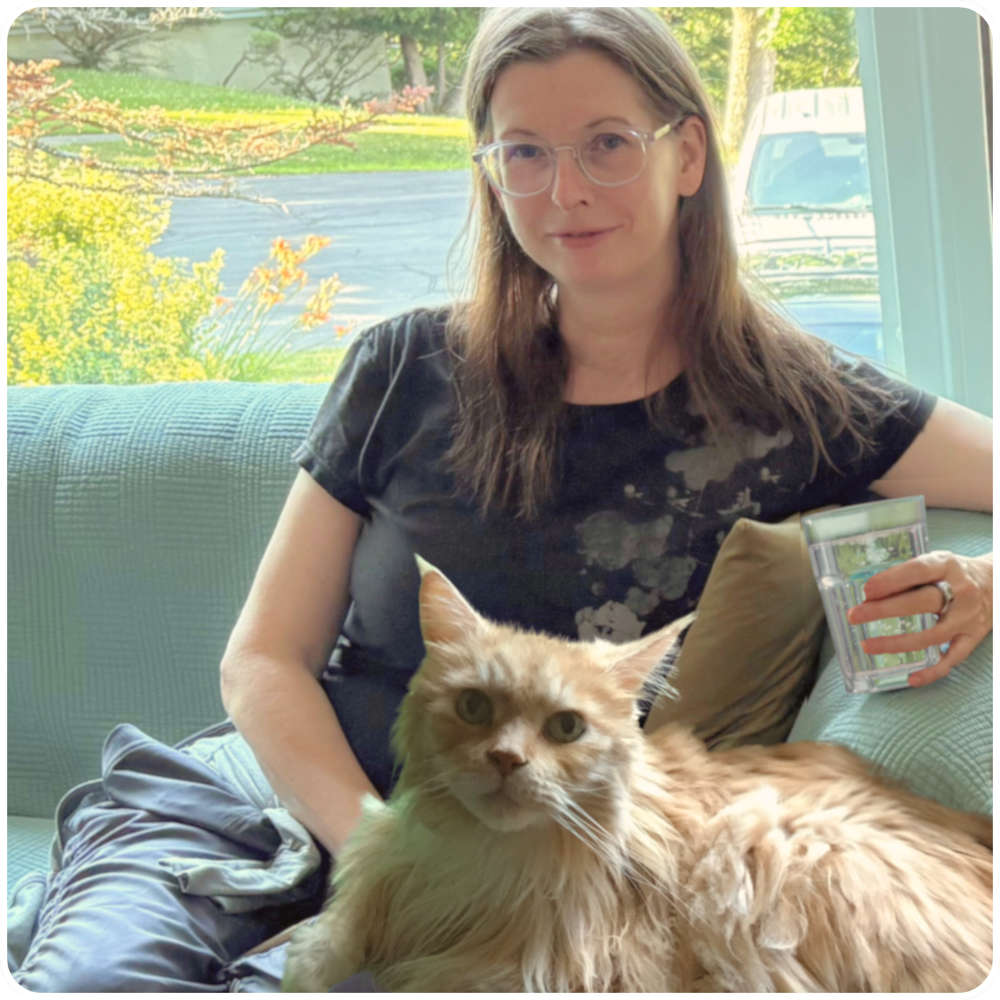- Home
- About Maine Coon Cats
- The Maine Coon Tail
Disclosure: this site is reader-supported. When you buy through links on our site, we may earn a small commission, at no extra cost to you.
The Magnificent Maine Coon Tail
•
The Maine Coon tail is spectacular. This big, bushy, plumelike feature is one of their most famous, and it's truly a sight to behold!
This breed is renowned for its striking appearance, including its impressive tail.
If you like this, you'll love our fun, free Daily Digest!

If you like this, you'll love our fun, free Daily Digest!

Quick Facts:
Here are some fun facts about the magnificent Maine Coon Tail:
- Length: The Maine Coon's tail is notably long, often almost as long as its body. It can measure up to 12 inches or more in length.
- Fluffiness: Along with its length, it is also characterized by its fluffy appearance. Maine Coons have a thick, bushy tail covered in long, flowing fur. This fur helps to keep the cat warm in cold climates, as they originated in the chilly northeastern United States.
- Plume: It often ends in a plume, a luxurious tuft of fur that adds to its majestic appearance. This plume can be quite eye-catching and is one of the distinguishing features of the breed.
- Versatility: This breed is known for its agility and athleticism, and their tails play a crucial role in maintaining balance and agility. They use them for balance when climbing, jumping, or maneuvering in tight spaces.
- Communication: Like all cats, Coonies use them to communicate. They may twitch or flick them in different ways to express various emotions, such as excitement, contentment, or agitation. Observing a Maine Coon's tail can often give you insights into its mood.
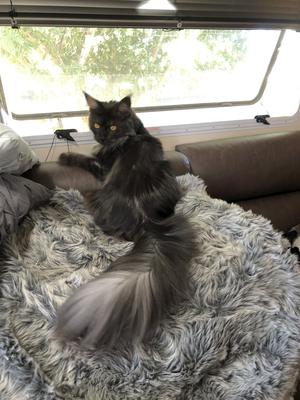 Georgina and her bushy tail
Georgina and her bushy tailMaine Coon Tail Thinning:
"Why is my Maine Coon's tail thinning?" Variations of this question have come up from time to time in our community. Of course, this is a question to ask your veterinarian and this is our advice.
In the meantime, though, you likely want to know more about the possible causes for a thinning tail.
Genetics: While Maine Coons are generally known for their luxurious coats, individual cats can inherit genes that affect the thickness and density of their fur, including that of their tails.
If thinning fur in this area runs in the cat's family, it could simply be a result of genetic predisposition.
Nutritional Deficiencies: Another common culprit could be nutritional deficiencies. A balanced diet is crucial for maintaining healthy skin and coat in cats, including Maine Coons.
If your cat is not receiving adequate nutrition, it could lead to thinning fur. Ensure your cat's diet includes high-quality protein, essential fatty acids, vitamins, and minerals to support coat health.
Underlying Health Issues: It could also be a sign of an underlying health problem. Conditions such as hormonal imbalances, thyroid issues, skin allergies, or parasites (such as fleas or mites) could affect the quality and thickness of your cat's fur, including that on the tail.
If you suspect a health issue, it's essential to consult with your veterinarian for a proper diagnosis and treatment plan.
Stress or Anxiety: Felines are sensitive creatures, and stress or anxiety can manifest in various ways, including changes in coat condition.
If your Coonie is experiencing stress due to changes in their environment, routine, or social dynamics, it could contribute to thinning tail fur. Providing a calm, stable environment and addressing any sources of stress can help improve coat health.
Grooming Habits: Lastly, consider your cat's grooming habits. Maine Coons are typically good self-groomers, but factors such as age, mobility issues, or even dental problems could affect their grooming abilities.
If your kitty is not grooming properly, it could lead to matting, tangles, and thinning fur.
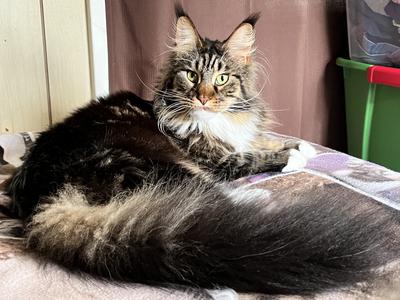 Violet Gray has a Magnificent Tail!
Violet Gray has a Magnificent Tail!Thinning fur in a Maine Coon tail could be due to genetics, nutritional deficiencies, underlying health issues, stress, or grooming habits.
Keep an eye on your cat's overall health and behavior, and consult with your veterinarian if you have concerns about their coat condition. With proper care and attention, you can help your Coonie maintain its majestic tail fur.
Mats and Grooming
Disclosure: this site is reader-supported. When you buy through links on our site, we may earn a small commission, at no extra cost to you.
Anyone who’s had a Maine Coon knows their tail is one of the most iconic features. But with their full, dense fur comes the challenge of managing mats, which can form in the tail and hide beneath the layers.
To prevent mats, groom your Coonie’s tail at least twice a week, or more often during shedding seasons.
- A slicker brush#link or wide-tooth comb#link is best for detangling, but always be gentle - especially near the base, as the skin there can be sensitive.
Maine Coon tail fur is denser and thicker than their body fur, with softer hair near the base and fluffier tips.
- A cat-safe leave-in conditioner#link can help ease tangles and reduce static.
If you find a mat, don’t panic! Gently work it out with your fingers or comb. If it’s too stubborn, carefully cut it with blunt-ended scissors. Always avoid pulling to prevent discomfort.
The skin around the tail can be sensitive, so be patient and stop if your cat seems uncomfortable.
Whatever you do, don’t feel guilty if you do find tail mats - they happen to the best of us. Regular grooming, the right tools, and patience will keep their tail looking fantastic!
Tail Over Paws: A Subtle Sign of Comfort
When a cat curls up with their tail tucked neatly over their paws, it's more than just an adorable pose.
That tail serves as both a heater and a comfort cue - a way to conserve warmth around the paws while maintaining a calm, composed posture.
Behaviorists often describe this as a "contained rest" position. Cats use it when they're relaxed but not completely switched off, keeping their limbs close and their senses alert.
It's a quiet display of security, the kind of body language you'll see when a cat feels safe in their space but still aware of their surroundings.
If your cat’s tail is softly draped, it usually means they're content. A tighter wrap might signal mild caution or attentiveness, depending on context. Either way, that tidy placement tells you one thing clearly: they're comfortable, and they trust where they are.
 Ellie, from our Breeders Testimonials Page
Ellie, from our Breeders Testimonials PageWhen Does a Maine Coon Kitten's Tail Fill In?
Maine Coon kittens are born with a certain amount of fur on their tails, but the full, bushy appearance characteristic of the breed develops gradually over time.
The timeline for when a kitten's tail fur fills in can vary depending on individual genetics and growth rate. Here's a general overview:
Birth to a Few Weeks Old: Coonie kittens are born with some fur on their tails, but it is typically short and sparse compared to the adult coat. During the first few weeks of life, kittens grow rapidly, and their fur starts to become denser.
Two to Six Months Old: As the kittens continue to grow and develop, their fur in the area becomes longer and more abundant.
By the time they are a few months old, the tail fur may start to resemble that of an adult, although it may still be softer and less dense.
Six Months to One Year Old: During this period, the fur on a Maine Coon kitten's tail continues to fill in and thicken, approaching the full adult coat.
By the time they reach one year of age, many kittens will have a tail that closely resembles that of an adult in terms of length and fluffiness.
One Year and Beyond: While the Maine Coon tail fur may continue to mature and develop after the first year, significant changes are less noticeable compared to the earlier stages of growth.
By the time a Coonie reaches adulthood, typically around three to four years old, their fur is fully developed, long, and bushy, with the characteristic plume at the tip.
Overall, a kitten's fur fills in gradually over the first several months of life, with significant progress made by the time they reach adulthood.
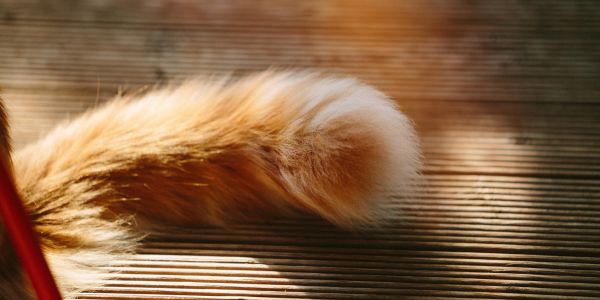 Fluffy Maine Coon Tail
Fluffy Maine Coon TailWhat is Stud Tail?
Have you ever seen a cat with a greasy area at the base of its tail?
Stud tail, also known as supracaudal gland hyperplasia, is a condition that primarily affects intact (un-neutered) males, although it can occasionally occur in females or neutered males as well.
It involves the overactive or over-secretion of the sebaceous glands located at the base of the tail, leading to the accumulation of oily, waxy material and sometimes even inflammation or infection. Here are some key points about stud tail:
• Sebaceous glands: Cats have sebaceous glands throughout their skin, including near the base of the tail. These glands produce an oily substance called sebum, which helps to lubricate the skin and fur.
• Hormonal influence: The development of this condition is thought to be influenced by hormones, particularly testosterone.
This is why the condition is more commonly seen in intact male cats, especially during puberty and adulthood.
• Symptoms: The primary symptom is the presence of a greasy, waxy, or crusty substance around the base area.
The affected area may appear darkened or discolored due to the buildup of this material. In some cases, there may also be redness, swelling, or signs of infection.
• Causes: The exact cause is not fully understood, but it is believed to be related to the increased production or activity of the sebaceous glands in response to hormonal changes. Poor grooming habits or underlying skin conditions may also contribute to the development of this issue.
• Treatment: Treatment typically involves addressing the underlying hormonal imbalance by neutering.
Neutering male cats removes the main source of testosterone, which can help to reduce the activity of the sebaceous glands and improve the condition. In addition, affected felines may benefit from regular grooming to remove excess oil and debris from the affected area.
In severe cases or if there is evidence of infection, veterinary treatment may be necessary, including the use of medicated shampoos or antibiotics.
This is a relatively common condition in intact males, characterized by the overactivity of the sebaceous glands.
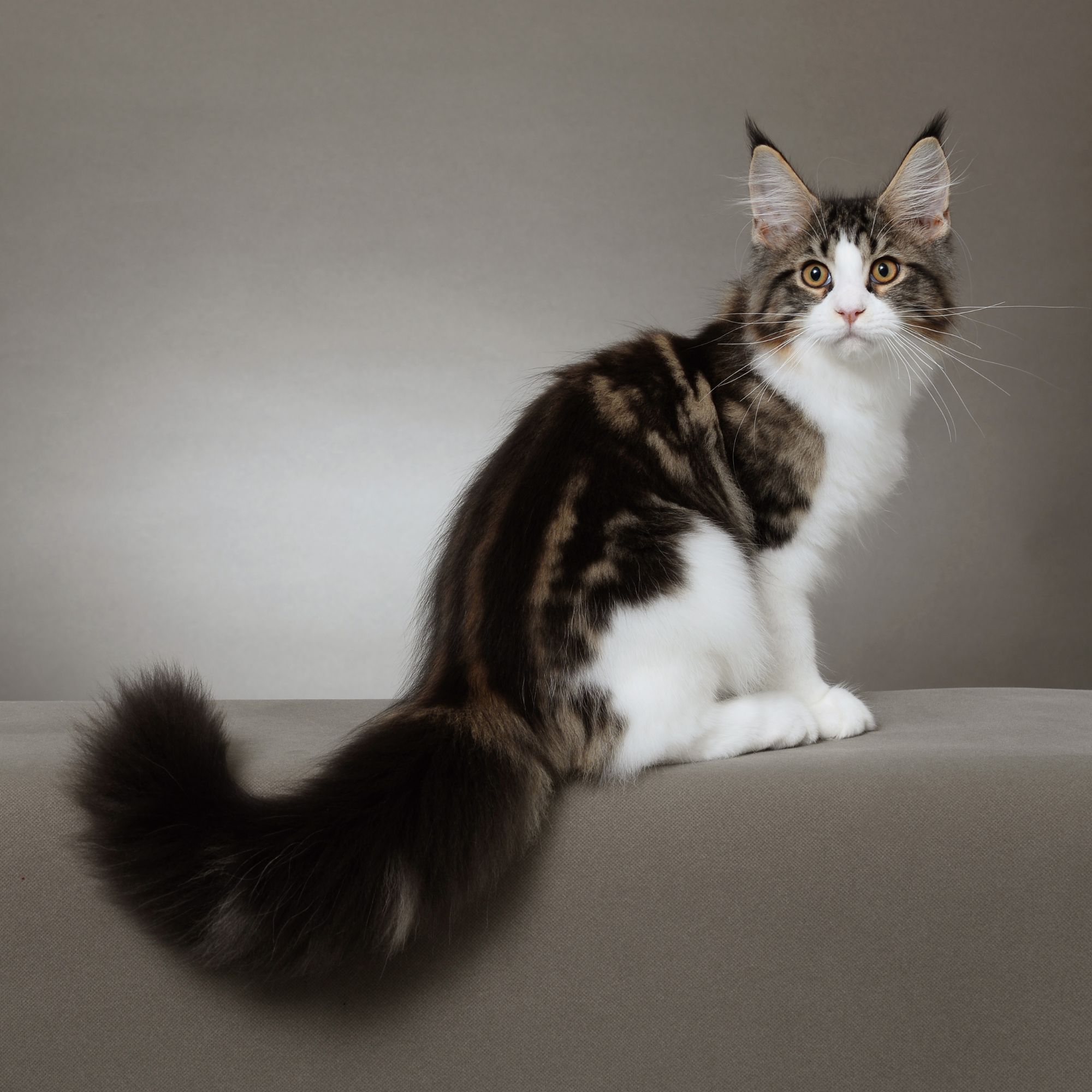 Young Coonie with a Fluffy Tail
Young Coonie with a Fluffy TailIf he's already neutered? Here are some more options for treatment:
- Cleaning and Grooming: Regular cleaning and grooming of the affected area are essential to remove excess oil, debris, and crusty material from the base of the tail. This helps prevent further buildup and reduces the risk of infection. You can use mild cat-safe shampoos or wipes recommended by your veterinarian for cleaning.
- Medicated Shampoos: Your veterinarian may prescribe medicated shampoos or wipes containing ingredients such as benzoyl peroxide or chlorhexidine to help reduce inflammation and control bacterial or fungal infections. Follow your veterinarian's instructions for using these products properly.
- Topical Treatments: In some cases, your veterinarian may recommend applying topical treatments, such as anti-inflammatory creams or ointments, to the affected area to help reduce inflammation and promote healing.
- Antibiotics: If there is evidence of infection, such as redness, swelling, or discharge, your veterinarian may prescribe antibiotics to treat the underlying bacterial infection. Follow your veterinarian's instructions for administering the antibiotics, and complete the full course of treatment as prescribed.
- Anti-inflammatory Medications: In severe cases of stud tail, your veterinarian may prescribe oral or injectable anti-inflammatory medications to help reduce inflammation and alleviate discomfort. These medications should only be used under the guidance of a veterinarian.
- Environmental Management: Ensure that your environment is clean and free from potential irritants or allergens that could exacerbate the condition. Provide a comfortable and stress-free environment for your kitty to help support overall health and well-being.
It's essential to consult with your veterinarian for a proper diagnosis and individualized treatment plan for your stud tail.
Your veterinarian can provide guidance on the best course of action based on the severity of the condition and your Coonie's overall health.
Neutering and proper grooming are typically effective in managing the condition and preventing recurrence.
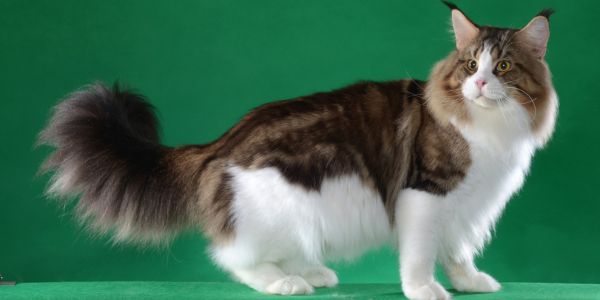
Maine Coon Tail Care
Questions from the Community:
A reader asks: "Hi we have two Maine Coons. The 3.5 year old's tail just seemed to get thinner and thinner. This week we groomed the 18 month old and included combing.
It was really thick and fluffy but after combing all the fluff came out and he too has now only a thin tail.
Were we wrong to comb it? Will it grow back? The older coon has never needed his combing so don't know why his is so thin?
They are fed on a really good diet - exactly as recommended by breeder - very varied and carefully mixed and measured.
Looking forward to some advice -thank you"
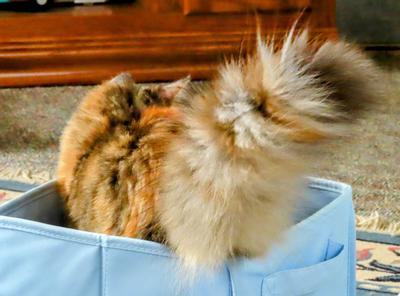
This can happen. It sounds like a combination of the combing and the time of the year. I'm not sure where you are, but if the weather is getting warmer, your cat's probably had a lot of fluff that had been shed but was still being held in place by all the other Maine Coon fur.
And, combing out that tail, especially if there were some tangles, will leave it thinner.
I think as time goes by, and cooler weather comes you'll see it thicken back up. For the future, try to comb the area sparingly, just where and when it's needed.
As for your older boy, perhaps it's just his genetics. Our Alice's tail was not particularly full. She had a different, silkier textured fur than her brother. Her tail didn't look super full, but it flowed and was thick enough and beautiful.
If you are concerned that it may be a health issue, ask your vet at the next check-up, or even give your breeder a call. It may just be a variation.
Hope This Helps!
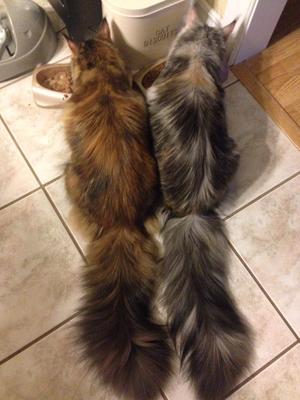 Moxie and Cali showing off their beautiful plumed tails at mealtime.
Moxie and Cali showing off their beautiful plumed tails at mealtime.Frequently Asked Questions (FAQ's):
"Why do cats have tails?"
"Why do cats have tails?"
This flexible appendage at the end of their spine serves crucial roles in balance, communication, and agility.
"How long should a cat's tail be?"
"How long should a cat's tail be?"
The length varies depending on the breed and individual genetics. Generally, it should extend to complement the cat's body proportions, aiding in balance and communication.
Breeds like the Manx naturally have shorter spinal extensions, while others, like the Maine Coon tail, are longer. Regardless of length, it contributes significantly to a feline's agility, helping it navigate its surroundings with precision and grace.
"Do cats feel pain in their tails?"
"Do cats feel pain in their tails?"
Cats possess nerve endings throughout their bodies, including their spinal extensions, which can transmit sensations of discomfort or pain.
If the it is injured or affected by a medical condition, such as trauma, infection, or nerve damage, cats may experience pain.
Signs of pain can include vocalization, agitation, decreased activity, or changes in posture or grooming behavior. If you see signs of pain or discomfort and seek veterinary care.
"Why do cats twitch their tails?"
"Why do cats twitch their tails?"
Felines do this as a form of nonverbal communication, often twitching or moving them to convey various emotions or intentions.
A twitch can indicate excitement, curiosity, or anticipation. Conversely, it may also signal agitation, annoyance, or warning.
Noting the context and other body language can help interpret the meaning behind the twitching motion.
For instance, a rapid twitch accompanied by flattened ears and dilated pupils may signify aggression or fear, while a slow, deliberate twitch might indicate focus or interest.
Paying attention to your furry friend's overall demeanor and behavior can give you insights into his mood and intentions.
"Can you tell a cat's breed by its tail?"
"Can you tell a cat's breed by its tail?"
It can provide clues about its breed, as different breeds often have characteristic tail shapes, lengths, or fur patterns.
For instance, breeds like the Manx have naturally short or absent spinal extensions, while others, like the Maine Coon, typically have long, bushy ones.
However, while it can be a distinguishing feature, it's not always definitive for breed identification, as individual variation and mixed ancestry can also influence its appearance.
Other physical traits, such as body shape, coat color, and facial features, are usually considered alongside the spinal extension when determining a cat's breed.
For a full breakdown of these clues, check out our guide to physical Maine Coon traits.
"How can I tell if my cat's tail is injured?
"How can I tell if my cat's tail is injured?
Spotting a possible injury isn't always straightforward, but a few signs can help. Watch for changes in behavior, like reluctance to move or groom, and pay attention to any unusual vocalizations or signs of pain, such as hissing or growling.
Keep an eye out for visible signs of injury, like swelling, redness, or bleeding around the base of the spine. If your kitty seems unusually sensitive or protective of the area, or if you notice any of these symptoms, it's a good idea to have a vet take a closer look.
"Why do some cats have short tails?"
"Why do some cats have short tails?"
This is usually due to genetic factors or breed characteristics. Breeds like the Manx naturally possess shorter or even absent tails due to a genetic mutation.
Other factors, such as injury or medical conditions during development, can also be causes. While it may affect a cat's appearance, it typically doesn't impact their quality of life.
These kitties still lead happy, healthy lives, utilizing their unique features to navigate their environment just like their long-tailed counterparts.
"Is it normal for a cat's tail to puff up?"
"Is it normal for a cat's tail to puff up?"
Yes, this completely normal reaction is usually a natural response to feeling threatened, scared, or agitated. This "puffed-up" appearance is caused by the involuntary contraction of muscles, making it appear larger and more intimidating to potential threats.
It's a common behavior observed in cats when they feel threatened by other animals, unfamiliar people, or loud noises.
While it's a normal reaction, prolonged puffing up or frequent occurrences without an apparent trigger could indicate underlying stress or anxiety, warranting further attention and possibly intervention from a veterinarian or animal behaviorist.
"How can I help my cat with a sensitive tail?"
"How can I help my cat with a sensitive tail?"
There are a few steps you can take to provide relief. First, create a calm and comfortable environment to reduce stress, as anxiety can exacerbate sensitivity.
Ensure your pet's bedding is soft and supportive, and minimize loud noises or sudden movements.
Gentle grooming sessions with a soft brush can help keep the area clean and free of irritants.
If your kitty shows signs of pain or discomfort, consult with a veterinarian to rule out any underlying medical issues and explore potential treatment options, such as medication or specialized care techniques.
"Do cats wag their tails like dogs?"
"Do cats wag their tails like dogs?"
While cats and dogs both use this body part to communicate, their movements differ. Cats don't typically wag them in the same way dogs do.
Instead, they may twitch or flick them to convey various emotions or intentions. A rapidly twitching or thrashing motion can indicate agitation or arousal, while a slow, deliberate movement might signal focus or curiosity.
Each movement carries its own meaning, so paying attention to your pet's body language as a whole can help you understand its mood and behavior better.
A Natural Design Built for the Cold
Coonies, known for their origins in the chilly Northeast, developed thick, bushy tails that serve more than one purpose.
Beyond their beauty, these tails can wrap around the body like a built-in blanket, keeping them warm and protected through harsh winters.
It’s a perfect example of how nature shaped the Maine Coon's tail into something both practical and beautiful.
Learn more about their traits and characteristics in our full hub all About Maine Coon Cats.
